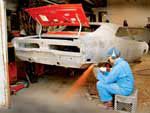
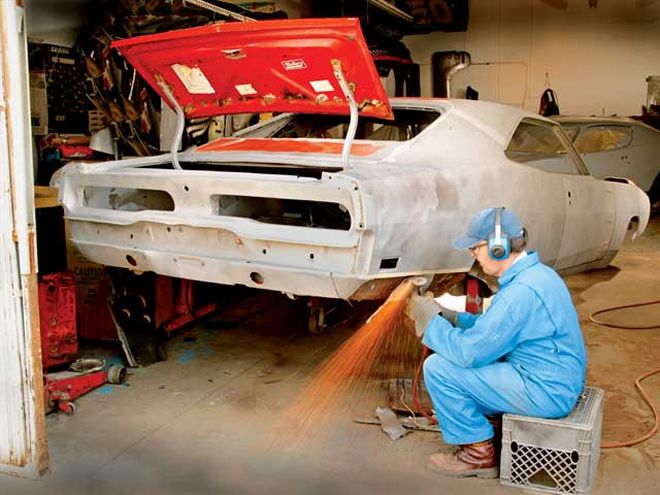
Comparing rust to cancer may be clich, but it fits. Both start as tiny, largely unseen conditions that, if left untreated, will certainly spread. Depending on the severity of the case, both can be terminal. And while there's no cure for either condition, if caught early enough, both can be treated, sometimes eradicating the problem altogether. The typical plan of attack for both consists of chemical treatment, surgery, or a combination of the two.
While science is still getting a handle on where cancer comes from, the origins of rust are no mystery: Metal corrodes. Iron, the basic building block of our cars, undergoes a chemical reaction called oxidation when it comes in contact with air and water. Rust is the crusty result of that process.
Preventing the formation of rust involves putting some sort of barrier between the iron we want to protect and the air and water that strive to destroy it. The barriers take many forms-paint, plate, grease, and the long list of chemical treatments that promise to inhibit or completely prevent rust from forming.
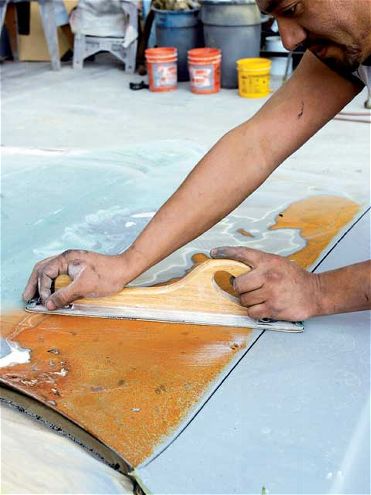 Not all rust treatments have to be expensive or chemically messy. If surface rust is the extent of your oxidation trouble, you can grind it off using a disc sander or long board and some 36-grit paper.
Not all rust treatments have to be expensive or chemically messy. If surface rust is the extent of your oxidation trouble, you can grind it off using a disc sander or long board and some 36-grit paper.
Yet, as hard as we try to keep rust at bay, it takes but a small chink in the armor to open a hole in the defenses, a hole that ambient conditions soon exploit to start the oxidation process. Once oxidation starts, the strategy has to move from prevention to eradication to keep it from spreading.
Rust eradication is the focus of this installment of our Ultimate Guide to Paint & Body. Over the next few pages, we'll look at a number of rust treatments, some simple, some not so, that can be used to clean and prep oxidized metal prior to paint.
It's important to be aggressive when fighting rust, as any oxidation left behind will contaminate, and ultimately ruin, that brand-new paint job you tried so hard to get just perfect.
Surface RustKnowing how to treat rust begins with assessing the affected metal and determining how deep the rust has gone. If there are no obvious holes in the rusted metal, if the metal doesn't feel thin or flimsy when you push on it, or if the rusted areas are bright orange, as opposed to a deeper, brownish-red tint, chances are good you're dealing with surface rust that hasn't compromised the metal's integrity.
Getting rid of surface rust can be as simple as grinding it off with coarse (36-grit) sandpaper. Certain types of blasting media, such as aluminum oxide and Starblast, are also aggressive enough to cut through surface rust.
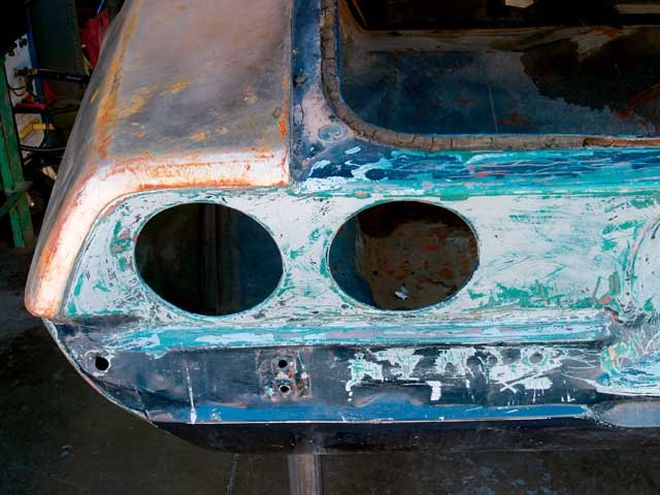 Surface rust also responds well to media blasting, provided the medium is aggressive enough. Note the layer of crust on the left-rear quarter of this '73 Camaro. This car has already been chemically stripped and sanded, and it's going into the blasting booth at A&M Sandblasting in Chatsworth, California, for a final stripping.
Surface rust also responds well to media blasting, provided the medium is aggressive enough. Note the layer of crust on the left-rear quarter of this '73 Camaro. This car has already been chemically stripped and sanded, and it's going into the blasting booth at A&M Sandblasting in Chatsworth, California, for a final stripping.
And then there are the chemical treatments. These fall into two general types: rust removers and rust sealers. The removers also fall into two types. Acid-based solutions, whether liquid, spray, or gel, dissolve the iron oxide. Some, like Eastwood's Oxisolv, leave behind a zinc phosphate coating for temporary protection against new rust forming prior to paint. Acid-free solutions use a process called chelating (pronounced KEE-lating) that, as Eastwood's John Sloane describes it, "grabs hold of unwanted compounds and pulls them away, leaving clean metal behind."
Acid solutions generally work faster than nonacidic chemistry, and the dissolving process can be accelerated by heating the remover. But acids are harsher than acid-free products, and they can etch and actually thin the metal if left on too long. The acid-free chemicals are gentler on the metal, less toxic, and won't harm plated coatings should you accidentally splash some beyond the area you're cleaning, Sloane says. They do take longer to work and require more material to clean a given area, but Sloane believes the acid-free chemicals, because of their more forgiving nature, may be a better choice for the at-home do-it-yourselfer.
Once the metal is rust-free, it should be primered or sealed to keep rust from forming again. Before that takes place, it's common for the metal to exhibit some flash rust, Sloane says, especially since most rust-dissolving chemicals are neutralized by rinsing the treated surface with water. "Going back over the metal with a rag coated in Oxisolv or another rust dissolver gets rid of the flash rust, then you can go back over the area with a rag coated in acetone or our Pre Painting Prep," Sloane advises. "Then you have a surface that's ready for paint."
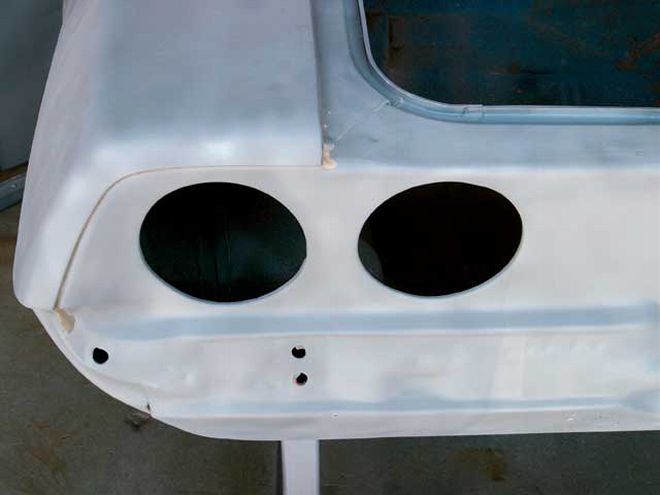 Here's that same corner after A&M hit it with DuPont's Starblast. Not a bit of oxidation-or paint, primer, or even trunk weatherstripping-is left.
Here's that same corner after A&M hit it with DuPont's Starblast. Not a bit of oxidation-or paint, primer, or even trunk weatherstripping-is left.
Rust sealers don't remove rust. Instead, they cover it with a barrier coating that keeps air and moisture away from the metal preventing further corrosion. Most of these products are designed to be sprayed or brushed right onto a rusted area once all the loose oxidation has been cleaned off.
One of the best known sealers is POR-15, a polyurethane, paint-like product that cures by exposure to moisture and bonds to the rusty metal to form a solid, nonporous coating. POR-15 can be used for any number of automotive-related jobs, from treating rusted trunk floors to restoring steering wheels. (In fact, the company has developed kits for those two tasks and others as well.)
Eastwood makes a similar product called Rust Encapsulator, a slow-cure fortified enamel with tiny glass flakes that act as a sealer. Like POR-15, it can be brushed or sprayed directly onto the oxidized metal once the loose rust has been ground off. Both POR-15 and Rust Encapsulator can be used in combination with body filler, and both can be painted over. In fact, the makers of POR-15 recommend topcoating their product, as prolonged exposure to the ultraviolet rays in sunlight can break down POR-15.
Deeper Rust
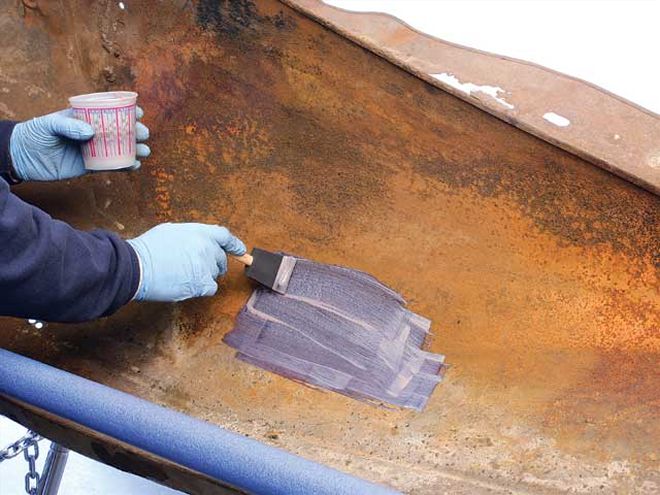 There's a long list of chemical rust removers and treatments. Eastwood's Rust Converter, for example, turns rusted metal into an inert black oxide that can be covered with a rust sealer or primer.
There's a long list of chemical rust removers and treatments. Eastwood's Rust Converter, for example, turns rusted metal into an inert black oxide that can be covered with a rust sealer or primer.
If your car's cancer goes deeper than superficial rust, it's time for surgery. Removing the rusted area can be limited to cutting away a small section of sheetmetal and patching it, or it can go as far as replacing an entire body part. Which tactic you use depends on how extensive the rust damage is, the relative difficulty of the repair (How accessible is the area? How good are your welding skills?), and the availability of replacement sheetmetal. It may be less expensive and ultimately less time-consuming to replace a body panel than it would be to repair it-provided, of course, you can get the repop or N.O.S. sheetmetal. At one shop we visited, a bodyman was faced with patching Fred Flintstone-like holes in the floor of a '49 Pontiac sedan. Repop was not an option; he had to hand-fashion the floor, with its factory-like stampings, out of scrap steel.
That floorpan was just one of many rust-repair jobs photographed for this story; check out the accompanying pictures to see some examples of various problems and their solutions. Several of these fixes were done at Johns Customz & Performance in Torrance, California. While we were there, we picked the brain of John Morrow, one of the shop's principles, for tips on successful rust repair.
Morrow says if you're going to cut out a rusted area and patch it, be sure to cut out at least half an inch beyond the rust hole to make sure you're bonding the patch to uncontaminated metal. When MIG-welding the patch panel, be careful about building heat in the weld area or you could distort the panel, he warns. Instead of doing a continuous weld, start at one corner, weld a portion, then move to the opposite corner. "Bounce around that area with small bead welds to keep heat buildup to a minimum," he says.
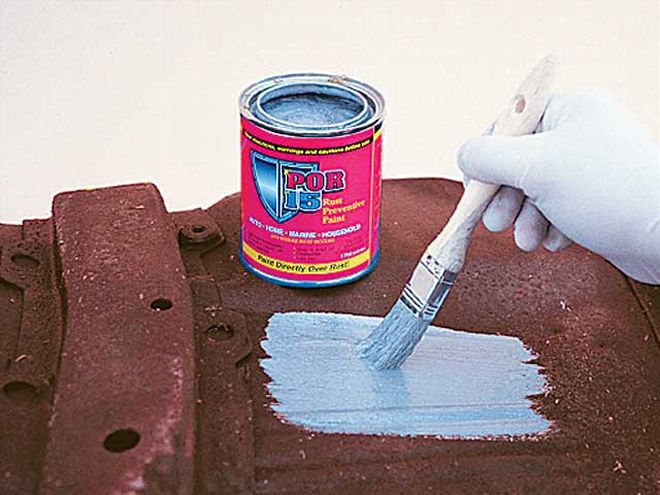 POR-15 is a polyurethane sealer that is applied directly to a rusted area (after removing any loose surface rust) to prevent further oxidation. It's available by the pint, quart, or gallon, and it comes packaged in a number of kits tailored to specific repair jobs, like steering-wheel restoration or floorpan repair.
POR-15 is a polyurethane sealer that is applied directly to a rusted area (after removing any loose surface rust) to prevent further oxidation. It's available by the pint, quart, or gallon, and it comes packaged in a number of kits tailored to specific repair jobs, like steering-wheel restoration or floorpan repair.
If you're an inexperienced welder, Morrow recommends lap-welding the patch panel to the hole rather than butt-welding it, as joining two overlapped pieces is easier than going through the process of trimming the patch to the exact size you want-just a little smaller than the hole to leave room for the weld-and controlling the weld to just fill the space between the patch and the original metal. He also recommends putting the patch underneath the original panel and welding the old metal on top of the new. "When it comes time to cover the welded area with body filler, it's easier to fill that way, since you only have the low section of the new panel to fill." Otherwise you'd have to feather the body filler over a much wider area to blend the raised patch into the rest of the panel.
If your repair encompasses an entire quarter-panel, your challenges go far beyond the lap- or butt-weld varieties. Quarter-panel replacement is a task that requires mad welding skills (and experience using body solder if you want to duplicate the factory leading), the patience required to align several body pieces at once, and a keen eye for keeping door and trunk gaps consistent. The folks at Goodmark Industries provided us with photographs of a quarter going onto their project '71 Camaro at the company's new Installation Center, and they shared some helpful tips for doing the job right.
"Before you start anything, make sure your door hinges are in good condition," Goodmark's Barbara Hillick says. "If they have the typical sagging that comes with old age, rebuild them or get new ones before you start. Everything from the fender to the rear quarter is lined up with the door. If you don't get your gaps right here, you might as well forget it."
Also key to proper panel alignment: proper placement of the car on jackstands. "Be sure to place the jackstands so the springs are loaded. When the back end of your car sags because your jackstands are in the wrong place, you'll never get anything to line up," Hillick advises.
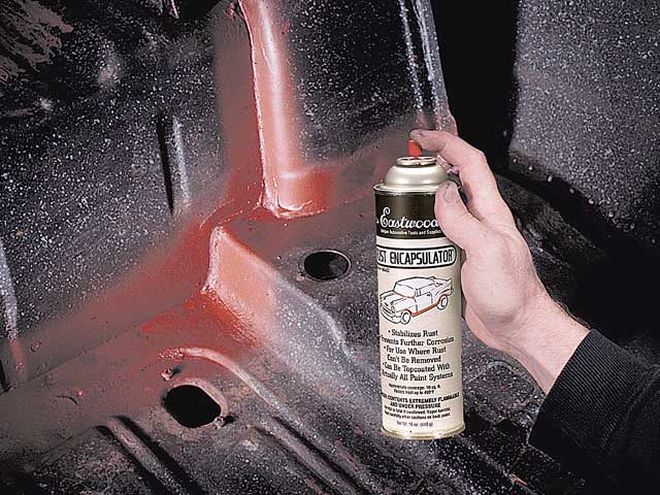 Like POR-15, Eastwood's Rust Encapsulator is a sealer that's also applied directly to rusted surfaces. Its chemical makeup is different, however, and it incorporates fine glass flakes to form an oxidation barrier.
Like POR-15, Eastwood's Rust Encapsulator is a sealer that's also applied directly to rusted surfaces. Its chemical makeup is different, however, and it incorporates fine glass flakes to form an oxidation barrier.
Once you get the old quarter-panel off, if you find extensive rust elsewhere in the car, for instance in the trunk or wheelwells, it's best to "do all the needed work at one time," Hillick says. Don't be tempted to leave a rusted area untreated, she adds. "If you do, you can be sure that it will reappear on your new quarter sooner or later."
As Morrow mentioned earlier about patch panels, be very careful about heat buildup when welding quarter-panels. Hillick says, "Never weld in a continuous bead here. This causes the panel to get too hot and distort. Put welds about an inch or so apart and then go back and fill in. Move around the area so the metal won't overheat." In the case of this Camaro, all the welding was done with a gas tri-mix MIG welder using 0.023-inch wire. "This wire requires less amperage so there is less heat buildup and distortion," she says.
This brings us to the end of the metal-repair portion of our series. Next month we'll get into what to do with your car's sheetmetal when it's almost ready for its first coats of paint.
How-To: Chemical Rust Remover
At Johns Customz & Performance (JCP) in Torrance, Calfornia, we watched Alberto Gonzalez make several rust-related repairs on a door from a '49 Pontiac sedan. This section of the door's inner panel was covered in surface rust.
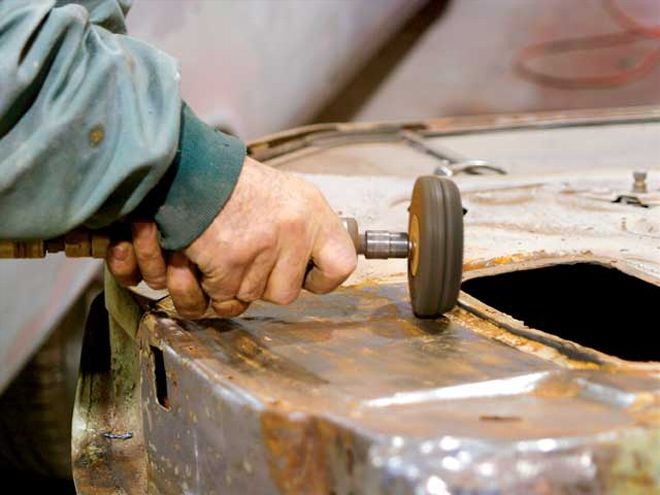
Gonzalez first removed the loose oxidation with a stripping wheel.
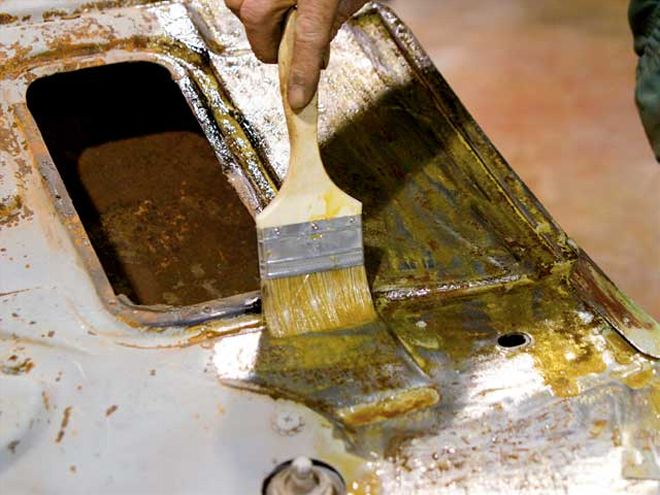
He then applied Harvey's Gel Rust Remover, a rust dissolver that contains hydrochloric acid and rust inhibitors. The gel can be left on the metal for minutes or hours, depending on the severity of the rust being treated. Be sure to monitor the process, though, as acidic dissolvers can also etch or thin metal if left on too long.
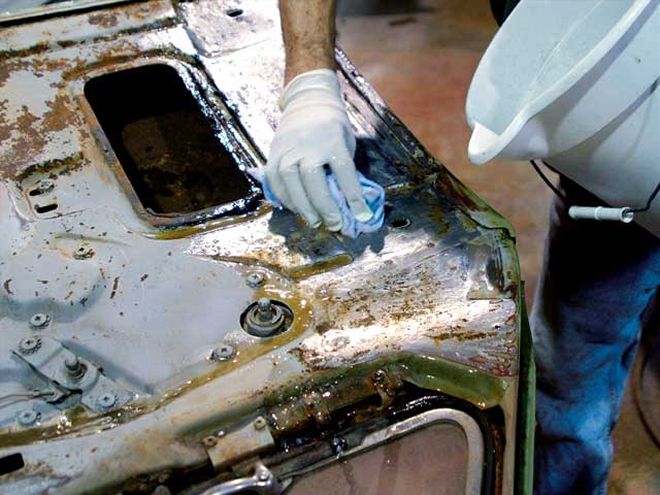
After just a few minutes, Gonzalez neutralized the gel with a rag soaked in water. Yes, it seems weird to introduce water into rust repair, but that's how it's done.
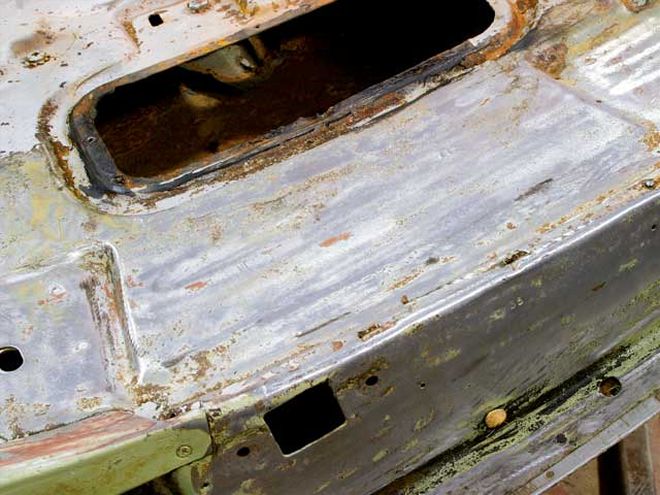
Here's the cleaned section. Additional treatments with the gel will remove all the surface rust. Then, to prevent flash rust from forming, Gonzalez will spray the door panel with a sealer primer.
How-To: Patch Panel
In another area of the JCP shop, Matt Sims was repairing damage caused by rusted floor panels and crossbraces under a '71 Olds Cutlass convertible. After removing one of the crossbraces, he found a nasty hole, which needed to be cut out and patched.
How-To: Quarter-Panel Replacement
Entire stories have been published about how to replace quarters; here we'll just go over some of the main steps of a panel installation done at Goodmark Industries' new Installation Center in Cleveland, Georgia.
How-To: Panel Fabrication
Rare or off-brand cars can't count on a big supply of reproduction body parts when a rusted panel needs replacing. In these situations, a donor panel must be found, or a new piece must be fabricated. JCP's Alberto Gonzalez is a master metal shaper and can do amazing things with a torch, some scrap steel, and a body hammer.
Tools You'll Need